Table of Contents
IEA: Global Expansion of Photovoltaics and Wind Power Surpasses Government Targets
The International Energy Agency (IEA) projects that by 2030, renewable energy will account for nearly half of global electricity generation—specifically, 46%. Renewables are expanding at such a rapid pace that they are exceeding most government-set targets. According to the IEA’s latest report, “Renewables 2024,” about 70 countries, representing 80% of global renewable energy capacity, are expected to meet or surpass their renewable energy goals by 2030.

However, despite this optimistic forecast, the outlook remains cautious. By 2030, the share of renewables in overall global energy consumption is predicted to reach just under 20%. In the electricity sector, which is becoming increasingly crucial, the projected total installed capacity for 2030 will only be 2.7 times the level of 2022. This falls short of the tripling goal agreed upon at the 2023 COP28 climate conference, a milestone deemed necessary for achieving the IEA’s net-zero emissions target by 2050.
Still, the report emphasizes that reaching the 2030 interim goal is “entirely feasible” if governments seize current opportunities. This involves not just formulating new strategies but also improving cooperation with emerging and developing countries to create better financing conditions.
From 2024 to 2030, the IEA forecasts about 5.5 terawatts of newly installed renewable energy capacity globally, with 670 gigawatts expected to come online this year alone. For comparison, this is roughly triple the growth seen in the six years from 2017 to 2023.

Two primary drivers are highlighted in the report: solar power and China. Photovoltaics (PV) will account for 80% of this expected capacity, making it the leading renewable energy source by 2030, generating around 6,000 terawatt-hours annually. Wind power is also set to recover significantly, with the growth rate expected to double compared to the period from 2017 to 2023. By 2030, wind and hydropower will be almost on par, with wind slightly ahead at approximately 5,000 terawatt-hours. Together, solar and wind are predicted to surpass hydropower as the dominant renewable energy sources by the end of this year.
China is expected to contribute nearly 60% of the total global renewable energy expansion in the electricity sector by 2030, meaning that nearly half of the world’s renewable capacity will be installed in China. Among the major economies, India will experience the fastest growth, with 350 gigawatts of new capacity from 2024 to 2030—more than triple the addition in the previous seven years.
Switzerland Approves Removable Photovoltaic System on Railway Tracks

The Federal Office of Transport (FOT) has granted approval for the first removable photovoltaic system on a railway line in Switzerland. Developed by the Swiss start-up Sun-Ways, the installation will be deployed next year on a 100-meter section of the Trans N railway line 221, operated by the public transport company of the canton of Neuchâtel.
The pilot system consists of 48 solar panels, each with a capacity of 380 watts, amounting to a total output of 18 kilowatts. The project will cost approximately €621,800, with the generated solar energy fed into the local grid.
Sun-Ways will collaborate with the local energy provider Viteos and DG-Rail, a company specialized in electrical railway systems, for the construction of the project. Initially, the FOT had rejected the proposal in the summer of 2023 due to the lack of technical information on the proposed technology.
In response, Sun-Ways partnered with industry experts and tasked two mechanical engineering professors from the Haute Ecole d’Ingénierie et de Gestion du Canton de Vaud (HEIG-VD) with conducting an independent evaluation of specially developed prototypes. Additionally, Geste Engineering, a Swiss specialist in large railway projects, performed a technical and safety analysis to demonstrate that the system meets the safety criteria required for operating on an active railway.
“With the growing controversies around the installation of photovoltaic plants in the Alps, Sun-Ways’ technology could provide a fitting solution to increase solar energy production,” the company stated. “It utilizes unused space without disrupting rail traffic or track maintenance and inspection activities.”
According to the company, the solar panels can be installed either manually or using a specially designed rail machine developed by Scheuchzer SA, an expert in railway maintenance. This machine can reportedly install up to 1,000 square meters of solar panels per day. Furthermore, the system is removable, allowing for easy removal during track maintenance.
Approval Tied to Several Conditions
The FOT’s approval is subject to several technical conditions, including additional tests and measurements to be conducted during the pilot phase to ensure that the system does not negatively impact the railway infrastructure.
Tests will also be carried out to demonstrate that the installation and removal of the Sun-Ways system align with the operational and maintenance requirements of the railway line. These trials will be supervised by RM voie ferrée, a company specializing in railway inspections and safety.
Study Recommends Controllability for Photovoltaic Systems Under 25 Kilowatts

The Fraunhofer Institute for Energy Economics and Energy System Technology (IEE) has published a study titled Analysis of the Controllability of Electrical Generators and Consumers, commissioned by the Federal Ministry for Economic Affairs and Climate Action. The study aims to illustrate how small decentralized generators, storage systems, and loads should be integrated into market processes and grid operations alongside large renewable generation plants in the future. This integration requires grid operators to have control over these systems, enabling them to adjust the power output as needed. The key question addressed is: At what capacity must systems be technically equipped for controllability?
The study is divided into two parts: Current Situation and Goal and Outlook. It examines various generation technologies, including photovoltaics, wind power, biomass, geothermal energy, hydropower, and conventional combined heat and power (CHP) systems. On the consumer side, it looks at electric vehicle charging points, heat pumps, night storage heaters, and electricity storage units.
Photovoltaics hold a special position in the study among the power generation types. In other technologies, small, non-controllable systems—typically up to 100 kilowatts—are either nearly nonexistent (such as in wind power) or represent only a small portion of the installed capacity. In contrast, for photovoltaics, where the threshold for controllability is now significantly lower at 25 kilowatts, the situation is far more complex. An analysis of the Market Master Data Register conducted for the study revealed that of the approximately 3.3 million recorded systems, around 90% fall into the category below 25 kilowatts. These systems account for about one-third of the total installed capacity, which stood at roughly 75 gigawatts as of August 2023; it has since increased to over 93 gigawatts, but the proportions have likely remained similar.
Forecasting whether the share of small systems in photovoltaics will decline as capacity expands, and if so, to what extent, is extremely challenging. Predictions for controllable consumers are even more difficult, as they—except for storage systems and public charging stations—are not subject to reporting requirements. For future planning, the study suggests it would be “extremely helpful” if private charging points and heat pumps were recorded in a uniform nationwide structure, similar to generation systems in the Market Master Data Register.
Despite these data gaps, particularly in the second part of the study (Outlook), which is based on many assumptions with variable input parameters, the authors already lean toward expanding grid and feed-in management to include smaller photovoltaic units. They consider it “likely that in the future, controllability or at least active response will be required for photovoltaic systems under 25 kilowatts.” The increasing use of Home Energy Management Systems (HEMS) and Smart Meters (iMSys), the authors suggest, will “make it possible to achieve this in a cost-effective and mass-market manner.”
Eon Survey: Rising Costs Threaten the Acceptance of the Energy Transition

A recent survey by Eon reveals that 72% of Germans believe that rising costs for promoting renewable energy pose a risk to the public’s acceptance of the energy transition. This concern spans all age groups and educational levels, with the highest regional worries in Thuringia (78%), followed by Mecklenburg-Vorpommern (77%), Saxony-Anhalt (76%), and Saarland (75%). The least concerned regions are Hamburg (66%), Berlin (67%), and Schleswig-Holstein (69%).
Debates about changing or eliminating solar subsidies are also prominent. According to the survey, 51% of respondents would refrain from investing in a photovoltaic system if the EEG feed-in tariff were abolished. However, 34% indicated they would still install a rooftop solar system even without any subsidies, and 32% said they would consider installing one if there were a one-time investment subsidy instead of the current feed-in tariff. Eon concluded from the survey that a significant portion of renewable energy expansion could happen even without subsidies.
Eon’s CEO, Leonard Birnbaum, recently commented that renewable energy sources no longer require operational subsidies. He emphasized the need to maintain system costs within a reasonable financial framework, focusing on affordability and acceptance of the energy transition. Lars Rosumek, Head of Corporate Communication & Policy at Eon, reiterated the importance of public perception of costs for overall acceptance. He suggested that now is the right time to reduce state subsidies for renewables, particularly for solar installations, where they are no longer essential.
While the demand for private rooftop photovoltaic systems is currently declining, plug-in solar devices remain popular, and this trend is expected to continue. Over 20% of renters surveyed expressed interest in acquiring a balcony solar system within the next five years, with 45% of respondents aged 30 to 39 sharing this interest.
French High Court rejects farmers’ union challenge against agrivoltaics

After the decree on agrivoltaics was issued in April 2024, the Confédération Paysanne declared its intention to file a legal appeal. The union believes agrivoltaics is “a marketing tactic designed to legitimize land and financial exploitation at a difficult time for the agricultural sector.” On June 6, the group filed an appeal with the French High Court (Conseil d’Etat), aiming to overturn Articles 1, 2, and 4 of Decree No. 2024-318 from April 8, 2024, which governs the development of agrivoltaics and the conditions for installing photovoltaic systems on farmland, natural areas, or forest land.
To support their case, the Confédération Paysanne asked the High Court to refer the matter to the Constitutional Council, raising concerns about the constitutionality of Article 54 of the law passed on March 10, 2023. “A detailed examination of the text leads us to question the constitutionality of the APER law,” the union stated. “We will submit a Priority Question of Constitutionality (QPC): Does the APER law violate the Environmental Charter by overlooking the environmental and biodiversity impacts of solar installations? Are the law’s vague definitions of agrivoltaics and solar power on supposedly uncultivated or unused land violating the constitutional principle of clarity and comprehensibility?”
In its ruling on October 3, 2024 (No. 494941), the High Court dismissed these arguments. “When passing Article 54 of the March 10, 2023 law, lawmakers aimed to boost renewable energy production while advancing the constitutionally recognized goal of environmental protection. Additionally, the new Article L. 111-30 of the Urban Planning Code stipulates that ‘agri-compatible’ installations must not permanently damage the soil’s ecological functions, including its biological, hydrological, and climatic functions, nor its agricultural potential,” the court clarified.
Moreover, a legal review noted that lawmakers established requirements for the reversibility of solar installations in natural, agricultural, and forest areas, along with mandatory financial guarantees. This, according to the review, ensures future generations’ rights are protected. “In conclusion, the High Court’s decision is particularly significant as it aligns renewable energy production with environmental protection. Rather than opposing these objectives, the court highlights that renewable energy – when properly regulated – contributes to environmental protection, which is a constitutionally recognized goal,” said Arnaud Gossement, a lawyer and associate professor at the University of Paris I Panthéon-Sorbonne. The Confédération Paysanne has yet to respond publicly to this ruling.
Since 2008, Maysun Solar has been dedicated to producing high-quality photovoltaic modules. Our range of solar panels, including IBC, HJT, TOPCon panels, and balcony solar stations, are manufactured using advanced technology and offer excellent performance and guaranteed quality. Maysun Solar has successfully established offices and warehouses in many countries and built long-term partnerships with top installers! For the latest quotes on solar panels or any photovoltaic-related inquiries, please contact us. We are committed to serving you, and our products provide reliable assurance.
Reference:
Enkhardt, S. (2024b, September 26). Eon-Umfrage: Steigende Kosten gefährden Akzeptanz der Energiewende. Pv Magazine Deutschland. https://www.pv-magazine.de/2024/09/25/eon-umfrage-steigende-kosten-gefaehrden-akzeptanz-der-energiewende/
Siemer, J. (2024, October 10). IEA: Weltweiter Photovoltaik- und Windkraftzubau übertrifft die selbst gesetzten Ziele der meisten Regierungen. Pv Magazine Deutschland. https://www.pv-magazine.de/2024/10/09/iea-weltweiter-photovoltaik-und-windkraftzubau-uebertrifft-die-selbst-gesetzten-ziele-der-meisten-regierungen/
Deboutte, G. (2024, October 4). Schweiz genehmigt abnehmbare Photovoltaik-Anlage auf Bahngleisen. Pv Magazine Deutschland. https://www.pv-magazine.de/2024/10/04/schweiz-genehmigt-abnehmbare-photovoltaik-anlage-auf-bahngleisen/
Siemer, J. (2024a, September 27). Studie empfiehlt Ansteuerbarkeit auch für Photovoltaik-Anlagen unter 25 Kilowatt. Pv Magazine Deutschland. https://www.pv-magazine.de/2024/09/27/studie-empfiehlt-ansteuerbarkeit-auch-fuer-photovoltaik-anlagen-unter-25-kilowatt/
Deboutte, G. (2024b, October 11). Le Conseil d’Etat rejette un recours déposé par la Confédération paysanne contre l’agrivoltaïsme. Pv Magazine France. https://www.pv-magazine.fr/2024/10/11/le-conseil-detat-rejette-un-recours-depose-par-la-confederation-paysanne-contre-lagrivoltaisme/
Recommend Reading:

Empowering Factories with Solar Energy A Strategic Tool for Controlling Production Electricity Costs
Commercial and industrial solar is becoming a key solution for factories to reduce electricity costs and hedge against price fluctuations. This article systematically analyzes its deployment models, cost advantages, and sustainable value pathways.

How Businesses Can Offset Carbon Taxes with Solar Power
This article analyzes the latest carbon tax policies and photovoltaic deduction strategies, helping European businesses legally reduce taxes, increase profits through solar investment, and achieve a win-win situation for both economy and environment.

Forecast and Response: Seizing the Next Decade’s Growth Dividend in Europe’s Commercial and Industrial Photovoltaics Market
Maysun Solar analyzes the growth trends of commercial and industrial photovoltaics in Europe over the next ten years, from policies and ESG to technological innovation, helping companies seize the initiative in the energy transition.

How to Calculate Solar System ROI and Optimize Long-Term Returns?
Solar power is becoming a key solution for businesses to reduce costs and improve efficiency. Accurately calculating ROI and optimizing long-term returns are essential to maximizing investment value.

Will Agrivoltaics Affect Crop Growth?
Agrivoltaics combines solar energy and agriculture to reduce up to 700 tons of CO₂ per MW, improve water use, and boost crop growth for sustainable farming.

6.5 Billion Loss Hits Photovoltaics: Reshaping or Elimination?
In 2025, the photovoltaic market may see a turnaround as some companies take early action. A €6.5 billion loss is driving businesses to explore new growth areas like energy storage and hydrogen. Which giants will break through? Industry transformation is accelerating!



